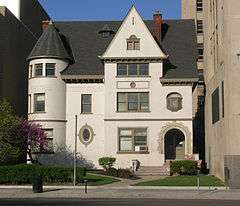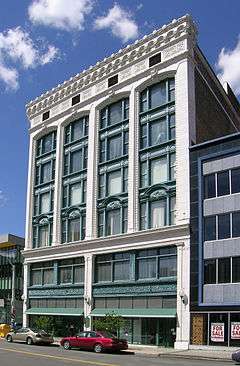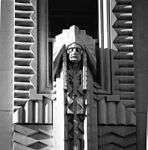Rogers and MacFarlane


Rogers and MacFarlane was an architectural firm based in Detroit, Michigan, founded in 1885 by James S. Rogers and Walter MacFarlane. The firm produced commissions in Detroit and southern Michigan from 1885 until 1912.
James S. Rogers (born in Alexandria, Virginia, December 5, 1859) was the son of James S. and Virginia (Leef) Rogers. He was educated in the public schools of Baltimore, Maryland, and attended Baltimore City College, and Massachusetts Institute of Technology. He married Eleanore White at Adamstown, Maryland, in June, 1895. He was the co-founder of the firm of Rogers & MacFarlane, then later Rogers & Bonnah, with offices at 1330 Penobscot Building in Detroit. He resided at 183 Seminole Avenue, Detroit, Michigan.[1]
Walter MacFarlane (born in Cold Spring, New York, June 15, 1859) attended Detroit Public Schools, and was a student at West Point, although he was not college–trained in architecture. He was first employed in the architect's office of Mr. Lloyd in Detroit. Later, he co-founded Rogers & MacFarlane, which maintained offices in Detroit for almost thirty years. MacFarlane left the firm in 1910 after suffering a nervous breakdown. After resting in Colorado and Arizona, he returned to Detroit in 1912 and formed a partnership with Walter Maul and Walter Lenz, architectural graduates of the University of Michigan (MacFarlane, Maul, and Lentz). MacFarlane married Mildred A. Griffin of New York October 14, 1914, in South Orange, New Jersey. He lived at 1053 Iroquois Avenue, Detroit, Michigan, until he died December 16, 1919.[2]
Rogers and MacFarlane were responsible for the design of many of the office buildings, banks and factories of Detroit, including the Morgan & Wright Bicycle Tire Company plant (later Uniroyal), the Cadillac Motor Works, the Murphy Power Plant on Congress Street (purchased by Detroit Edison June, 1914),[3] the King's China Store (L. B. King and Company Building), and a large number of the most beautiful homes in Detroit.[2]
Selected commissions
- Unless otherwise noted, buildings are in Detroit.
- Michigan Central Railroad Depot (Battle Creek, Michigan) (1888) - Since 1991 Clara's on the River restaurant [4] - Listed on the National Register of Historic Places in 1971.
- Samuel L. Smith House (1889) - Listed on the National Register of Historic Places in 1986
- Morgan & Wright Bicycle Tire Company plant, Jefferson Avenue, across from Belle Isle on the Detroit River (Later Uniroyal. Razed 1985)
- "King's China Store" L. B. King and Company Building (1910) - Listed on the National Register of Historic Places in 1987
- Henry L. Walker House, 1005 Iroquois, Indian Village Historic District (1899)
- Crescent Brass and Pin Company Building (1905) - Listed on the National Register of Historic Places in 2003
- John N. Bagley House,[5] 2921 Jefferson Avenue, Detroit, Michigan. Listed on the National Register of Historic Places in 1985.
Notes and references
- ↑ The Book of Detroiters. A Biographical Dictionary of Leading Living Men of the City of Detroit, Second Edition, Revised and Brought Down to Date, 1914, Edited by Albert Nelson Marquis, Copyright, 1914, by Albert Nelson Marquis. Retrieved 2010-05-10.
- 1 2 The City of Detroit 1701 - 1922 Volume V Illustrated. The S. J. Clark Publishing Company 1922. Retrieved 2010-05-10.
- ↑ "Detroit Edison's District Heating System (1903) Beacon Street Plant" (PDF). The American Society of Mechanical Engineers. Retrieved 2010-05-11.
- ↑ "Clara's on the River". Official company web site. Retrieved 2010-05-12.
- ↑ "John N. Bagley House (1889) 2921 Jefferson Avenue, Detroit, Michigan". Detroit - The Future and the History of the Motor City. Retrieved 2010-05-12.
Photo gallery
-
Michigan Central Railroad Depot (Battle Creek, Michigan) Now: Clara's on the River, restaurant. Listed on the National Register of Historic Places in 1971.
-

Samuel L. Smith House 5035 Woodward Avenue in Detroit, Michigan. Listed on the National Register of Historic Places in 1986.
-

L. B. King and Company Building, Detroit, Michigan. Listed on the National Register of Historic Places in 1987.
